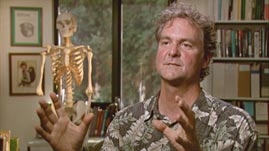Teachers' Domain - Digital Media for the Classroom and Professional Development
User: Preview


Source: KQED Quest: "The Reverse Evolution Machine"
This video adapted from KQED's QUEST examines one scientist's efforts to understand the DNA of extinct creatures so as to better understand the diversity of life today. Professor David Haussler works in the field of computational genomics, which relies on computers to reconstruct the genome of ancient creatures for which DNA is not preserved in fossils. By essentially running evolution in reverse, he scans the genomes of organisms that haven't changed over very long periods of time but then suddenly change, resulting in new species that evolve differently from one another.
As the number of fully sequenced genomes grows, our understanding of comparative biology improves. But it's not just the living species of plants, animals, and other organisms that become better known to us. As Dr. David Haussler explains, sequenced genomes allow scientists to look back in time to better understand the history of life. Haussler is trying to interpret the DNA of creatures that lived millions of years ago by reconstructing their DNA sequences. By reconstructing ancestral genes and maybe even entire genomes, he hopes to identify the common DNA sequences that exist between living and extinct species, as well as the changes in DNA that caused species to branch apart in the evolutionary "tree of life."
Haussler is a pioneer in the field of computational genomics. He programs computers to perform mathematical analyses and determine how ancestral genomes evolved. The programs are designed to identify and compare the proteins encoded by different genes in an attempt to understand the role of these genes and proteins in the biology of a species and evolution. It's a complex process because it has to account for the infinite number of possible combinations of long sequences of the four nucleotide bases (A, C, T, G) that make up DNA, and that are ultimately responsible for the tremendous variety of life on Earth.
In order to reconstruct ancestral genomes, Haussler has devised mathematical techniques to run evolution in reverse. Using these techniques, he compares the genomes of all types of living things at all levels, including the large-scale chromosomal rearrangements that have occurred as well as the insertions and deletions in individual bases. The mathematical operations must account for more than just single mutations in a gene's DNA sequence: they must also account for the complexity caused by DNA sequences that have been repeatedly duplicated and rearranged. From these comparisons, Haussler can see just when and where changes occurred across different species and use this information to determine what their ancestral genomes must have looked like.
Recent findings from Haussler's research lab include the existence of elements in the human genome that have been conserved (remained essentially unchanged) across millions of years of evolution. Conserved sequences suggest that species shared a common ancestor and are thus closely related, and they mostly code for "housekeeping" proteins that are essential to life. His team has also identified genome segments that have undergone unusually rapid change in one species but not in another closely related one, which allowed this species to evolve in a certain way. For example, Haussler may have found the change in a single gene (called HAR1) that is responsible for humans’ larger, more complex brains, which sets them apart from their close relatives, the chimpanzees. But these results are still preliminary. Humans and chimps diverged from a common ancestor about 5 million years ago.
 Loading Standards
Loading Standards Teachers' Domain is proud to be a Pathways portal to the National Science Digital Library.
Teachers' Domain is proud to be a Pathways portal to the National Science Digital Library.
